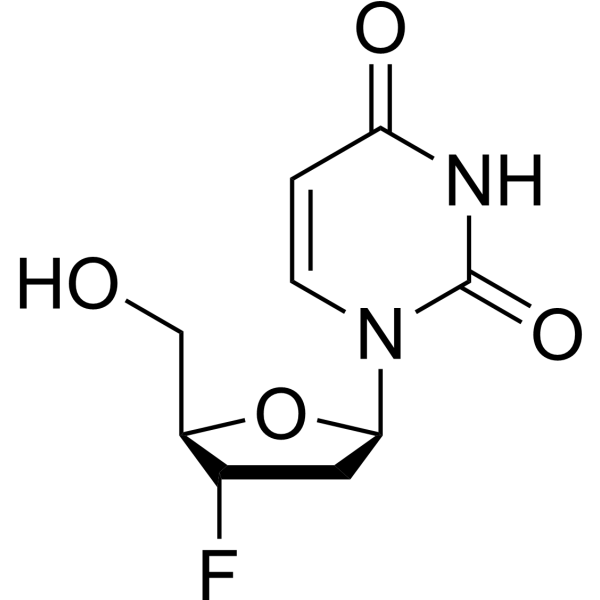Differential patterns of intracellular metabolism of 2',3'-didehydro-2',3'-dideoxythymidine and 3'-azido-2',3'-dideoxythymidine, two potent anti-human immunodeficiency virus compounds.
J Balzarini, P Herdewijn, E De Clercq
文献索引:J. Biol. Chem. 264 , 6127, (1989)
全文:HTML全文
摘要
3'-Azido-2',3'-dideoxythymidine (AZT) and 2',3'-didehydro-2',3'-dideoxythymidine (D4T) are potent and selective inhibitors of human immunodeficiency virus replication in MT-4 and ATH8 cells. They are also inhibitory to the replication of murine retroviruses, i.e. Moloney murine sarcoma virus-induced transformation of C3H cells. In MT-4 cells AZT is readily phosphorylated to its 5'-monophosphate, while the 5'-di- and 5'-triphosphates are generated to a 200-600-fold lower extent than the 5'-monophosphate. D4T is phosphorylated in MT-4 cells to its 5'-monophosphate at a 300-600-fold lower extent than AZT. The phosphorylation of AZT in the thymidine kinase-deficient cell line (Raji/TK-) is severely depressed, while D4T phosphorylation is only slightly diminished in Raji/TK- as compared to Raji/0 cells. D4T has a 10-fold lower affinity for phosphorylation by crude MT-4 cell extracts than AZT (Km, 142 and 14 microM, respectively), and the Vmax for phosphorylation of D4T is only 5% that of AZT. D4T is phosphorylated by MT-4 cell extracts about 180-fold less efficiently than AZT (Vmax/Km, 0.06 for D4T, as compared to 11 for AZT), and this is consistent with the differences found in the amounts of phosphorylated products of D4T and AZT formed in intact MT-4 cells. The 5'-triphosphates of AZT and D4T are equipotent in their inhibitory effects on the reverse transcriptases from human immunodeficiency virus and Moloney murine leukemia virus.
相关化合物
| 结构式 | 名称/CAS号 | 分子式 | 全部文献 |
|---|---|---|---|
 |
2',3'-二脱氧-3'-氟尿苷
CAS:41107-56-6 |
C9H11FN2O4 |
|
Synthesis and in vitro antiviral activities of 3'-fluoro (or...
2010-11-01 [Bioorg. Med. Chem. 18(21) , 7542-7, (2010)] |
|
Perspectives for the chemotherapy of AIDS.
1988-12-01 [Chemioterapia 7(6) , 357-64, (1988)] |
|
5-Chloro-substituted derivatives of 2', 3'-didehydro-2',3'-d...
1989-03-15 [Biochem. Pharmacol. 38(6) , 869-74, (1989)] |
|
5-Halogeno-3'-fluoro-2',3'-dideoxyuridines as inhibitors of ...
1989-05-01 [Mol. Pharmacol. 35(5) , 571-7, (1989)] |
|
Hiyama T
[Organofluorine Compounds: Chemistry and Applications , 153] |